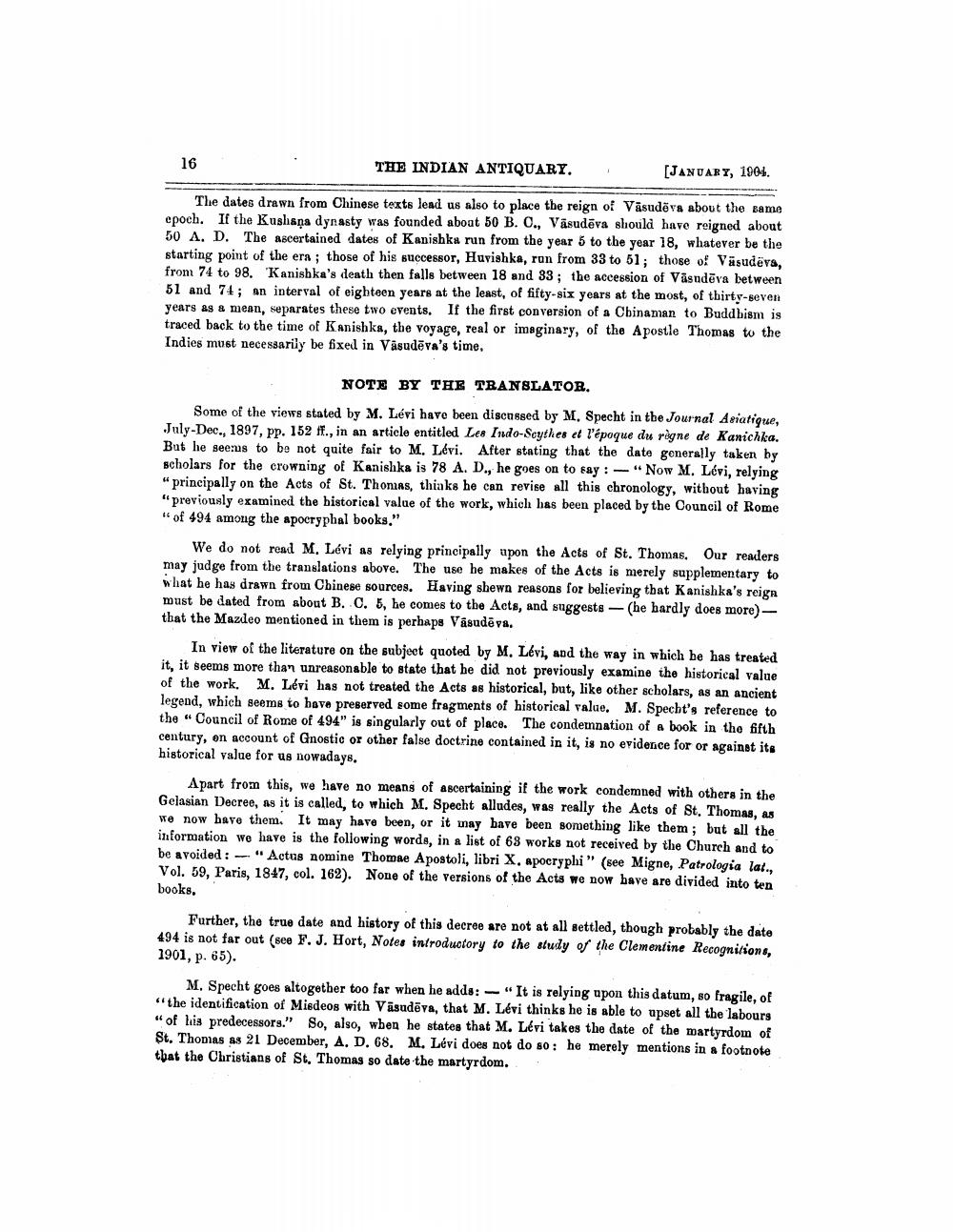________________
16
THE INDIAN ANTIQUARY.
[JANUARY, 1904.
The dates drawn from Chinese texts lead us also to place the reign of Vasudeva about the same epoch. If the Kushana dynasty was founded about 50 B. C., Vasudeva should have reigned about 50 A. D. The ascertained dates of Kanishka run from the year 5 to the year 18, whatever be the starting point of the era; those of his successor, Huvishka, run from 33 to 51; those of Vasudeva, from 74 to 98. Kanishka's death then falls between 18 and 33; the accession of Vasudeva between 51 and 74; an interval of eighteen years at the least, of fifty-six years at the most, of thirty-seven years as a mean, separates these two events. If the first conversion of a Chinaman to Buddhism is traced back to the time of Kanishka, the voyage, real or imaginary, of the Apostle Thomas to the Indies must necessarily be fixed in Vasudeva's time.
NOTE BY THE TRANSLATOR.
Some of the views stated by M. Lévi have been discussed by M. Specht in the Journal Asiatique, July-Dec., 1897, pp. 152 ff., in an article entitled Les Indo-Scythes et l'époque du règne de Kanichka. But he seems to be not quite fair to M. Lévi. After stating that the date generally taken by scholars for the crowning of Kanishka is 78 A. D., he goes on to say: "Now M. Lévi, relying "principally on the Acts of St. Thomas, thinks he can revise all this chronology, without having "previously examined the historical value of the work, which has been placed by the Council of Rome "of 494 among the apocryphal books."
We do not read M. Lévi as relying principally upon the Acts of St. Thomas. Our readers may judge from the translations above. The use he makes of the Acts is merely supplementary to what he has drawn from Chinese sources. Having shewn reasons for believing that Kanishka's reign must be dated from about B. C. 5, he comes to the Acts, and suggests (he hardly does more)that the Mazdeo mentioned in them is perhaps Vasudeva.
In view of the literature on the subject quoted by M. Lévi, and the way in which he has treated it, it seems more than unreasonable to state that he did not previously examine the historical value of the work. M. Lévi has not treated the Acts as historical, but, like other scholars, as an ancient legend, which seems to have preserved some fragments of historical value. M. Specht's reference to the "Council of Rome of 494" is singularly out of place. The condemnation of a book in the fifth century, on account of Gnostic or other false doctrine contained in it, is no evidence for or against its historical value for us nowadays.
Apart from this, we have no means of ascertaining if the work condemned with others in the Gelasian Decree, as it is called, to which M. Specht alludes, was really the Acts of St. Thomas, as we now have them. It may have been, or it may have been something like them; but all the information we have is the following words, in a list of 63 works not received by the Church and to be avoided: "Actus nomine Thomae Apostoli, libri X. apocryphi" (see Migne, Patrologia lat., Vol. 59, Paris, 1847, col. 162). None of the versions of the Acts we now have are divided into ten books.
Further, the true date and history of this decree are not at all settled, though probably the date 494 is not far out (see F. J. Hort, Notes introductory to the study of the Clementine Recognitions, 1901, p. 65).
M. Specht goes altogether too far when he adds: "It is relying upon this datum, so fragile, of "the identification of Misdeos with Vasudeva, that M. Lévi thinks he is able to upset all the labours "of his predecessors." So, also, when he states that M. Lévi takes the date of the martyrdom of St. Thomas as 21 December, A. D. 68. M. Lévi does not do so: he merely mentions in a footnote that the Christians of St. Thomas so date the martyrdom.




